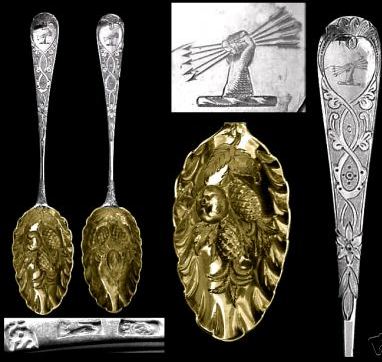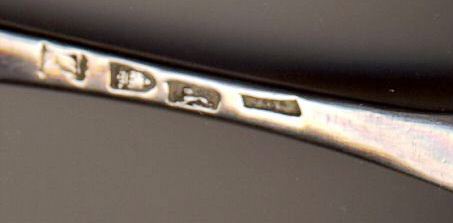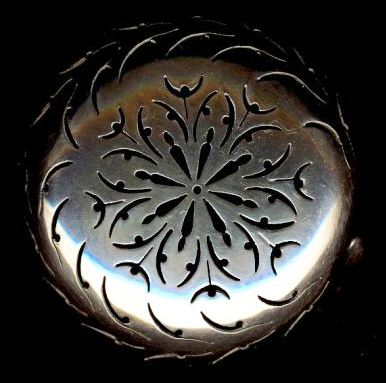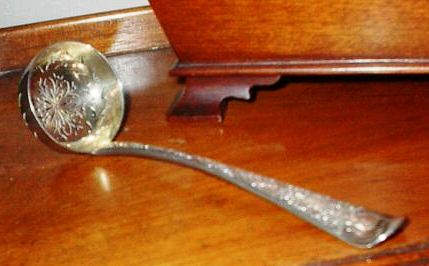I am thinking about collecting Georgian Flatware and would like some general collecting guidelines. In addition, it would be helpful to know some relative values. Are spoons more common than other items? I have heard that spoons made before 1811 were made by hand. So is it more desirable to collect pre-1811? Are London spoons generally less desirable than other provincial makers? Is it better to have items without crests. Should one go for size or scarcity? As an example, here are four seven inch William Chawner spoons. Two are in fairly good condition while the other two have dents in the bowl. How would you determine value on this set?
Wow, big question. I could write a book on this…
First, forget that 1811 thing. The hand made vs machine made issue is way more complex than a single date line. Some wonderful, English cutlery patterns were only produced post this date.
Now, regarding the condition of silver flatware… The most important single check to make regarding the condition of silver flatware is that the prongs of the forks and bowls of the spoons are nice and long. What happens with old cutlery is that with use the prongs and bowls get worn down and then the pieces are given to a silversmith who files them to to make them look even and symetrical again. This cannot be fixed. On the other hand, bent prongs on the forks, and dents in the bowls of the spoons are fixable by any decent silversmith and should not be considered too much of a problem.
Regarding price and availability, the issue is too complex for any single answer. Certainly, if you go pre about 1760, its much easier to find spoons than anything else. But this is a difficult period to collect from and you will struggle to put together a set that doesn’t look like its been assembled from oddments. After this date, you will be able to put together a George III Old English pattern set fairly easily. And if you move into the 19th century, you suddenly have a huge variety of possible patterns to choose from, Which pieces (table spoons, desert forks etc) are most rare and expensive depends on the pattern and period. For instance Queens pattern table spoons are very rare and worth much more than the other pieces in the set. In fiddle, again table spoons are rarer but also are desert forks. As such, the issue of price is something which can only be figured out with experience.
The spoons in your set are obviously fiddle pattern and where made in 1830 (did you think it was 1810??). If you like fiddle pattern, you really need to collect George IV or William IV or Victorian. Although fiddle did appear in the late George III period, it was much softer in look than your spoons. The classic fiddle design (like your spoons) is found from around 1830 onwards.
Regarding town of manufacture, London silver is incorrectly considered superior to Sheffield and Birmingham silver, but this does effect the purchase and resale value. (in the late Victorian period and twentieth century, London made pieces are generally better). Of course, provincial silver has a higher value. For instance, if you found a complete service of Channel Islands flatware it would be worth a fortune!
Hopefully, you can see that the situation is too complicated for any definitive rules. My advice would be the following. First decide what pattern of flatware you like. Once you have decided the pattern, you can decide on a date range and maker/group of makers to collect. Don’t think about it as a way of making money. The only way to make good money with collecting old flatware is to put together a single maker set with a short date range or better still, a single year, but this is very, very difficult. You’d do better to think of it as a fun project and one which is not going to lose you money. Make sure that any pieces you buy have long prongs and long bowls.
I could write lots more but I’m exhausted!
I hope that helps. Regards Jonathan
Hi, I just read Jonathan’s answer and realised he didn’t mention about crests. Most cutlery from the Georgian period would have been crested, if its not there it has probably been removed. If this is the case then check that the removal of it hasn’t left the pieces thin.
All the best
Daniel
Thank you both very much for the wealth of information. To be honest I am only now developing a silver collecting strategy. After reading your post and realizing how much sense it makes, in retrospect, I think I was looking at the spoons in terms of hoarding them just because they were old. I really don’t even like the fiddle pattern and yes the seller said they were 1810 and I didn’t bother to check. My taste in flatware patterns runs Art Nouveau, but I wish to start a small collection of George III silver as a compliment to my British Satire Prints from the period. As a start, I recently bought this pair of 1764/1771London Old English table spoons. I will consider continuing in this pattern based upon your wise suggestions and because it seems palatable to me. Any further advise on an Old English strategy? Another thought was just to collect a variety of English/Scottish Sterling serving pieces. The spoons below have already been analyzed by another helpful forum. You will see I have much to learn. Perhaps you would be kind enough to tell me more? How would you value these particular Georgian Spoons?
1764
1771
Regards,
Primroy
Well, now that you’ve decided on George III Old English, we can be a bit more specific.
Old English became fashionable at the beginning of George III’s reign and was a slight evolution of the Hanoverian pattern. There are two main differences between Old English and Hanoverian. First, the spoons of Old English turn down instead of up. Second, the forks of Old English are 4 prong whereas with Hanoverian they are 3 prong. Be suspicious if you find Old English pieces pre 1760 - they are usually modified Hanoverian.
Next, during George III’s reign the hallmarking of flatware changed in two main ways.
First, the place where the hallmarks were struck changed. Early flatware is ‘bottom marked’ (also called ‘stem struck’). Later flatware is ‘top marked’. Your pieces are bottom marked. Top marked flatware is marked at the very end of the handle. (you occasionally find pieces that could be called ‘middle marked’ but these are rare.). The change over takes place gradually from about 1770 onwards and by 1800 all pieces are top marked.
The other important change is the introduction of the George’s head duty mark in 1784. All Georgian pieces after this date carry an additional hallmark of the King’s head, showing duty has been paid.
As such, collectors tend to try to build up a set of simillar pieces. For instance, you might build a set where all pieces are ‘bottom marked’ or ‘King’s head’.
Importantly, the shape of Old English also changed during the George III period. Early George III Old English spoons have long oval bowls. Later spoons have egg shaped bowls and these can be quite pointy. As such, you should decide which bowl shape you prefer, as this will dictate the period.
I advice that you stick to pre 1800 pieces for your collection. This way you will avoid the problem of modified fiddle (ie fiddle with the shoulders and stem filed down). Also 17-something sounds more magical than 18-something!
I hope that helps you to get started! // Jonathan
P.S. the definitive book on flatware is Ian Pickford’s Silver Flatware. Unfortunately it is out of print and can be expensive to buy. If you find a cheap copy snap it up. Otherwise, try some libraries!
Thanks Jonathan for the excellent advise. I really appreciate your taking the time to share your knowledge.
Dear Learned Advisors,
I was trying to follow your advise by collecting lower mark and thought I was in heaven when I found two 8.5 inch 1771 spoons! Visions of a 1771 Old English canteen were floating in my head. I excitedly started doing some research. I discovered that five arrows represents Meyer Rothschild’s five sons, Amschel, Salomon, Nathan, Karl and Jakob. I just knew that I had found the banking heir’s spoons with the crest and all that gold. I searched in vain to identify the marks. I started getting troubled when I learned that bright cut engraving was popular in the late Eighteenth century. Then I learned that the gold wash was to protect the silver from the acidic berry juices. More problematic was learning that Berry spoons were a Victorian fashion and were in fact fashioned from original spoons-- monstrosities that stultified the pure form of real spoons! I looked at the bright gold wash and thought they aren’t pure 1771, so what are they really, and what have I done to the worth of my meager collection? ![]()
Yours,
Primroy

Hi Primroy,
I’m afraid that those spoons are Georgian table spoons, converted in the Victorian period to berry spoons. The vast majority of berry spoons were made in this way (see silver-collector.com/topic122.html). They still have value but they are not good additions to your future canteen! There are many modified items that collectors need to be aware of and fruit spoons are one of them. With flatware, another one to look out for are basting spoons converted to large salad forks.
Don’t let it bother you! The quickest way of learning is by not being afraid to burn your fingers occasionally!
Good luck! // Jonathan
Thanks very much Jonathan!
Thought I should post the marks to the Georgian berry spoons here rather than in the Gorham post.
I’m wondering if the first might be by James Ker, Edinburgh, 1746?
The second may be Robert Sallam, London, Unknown date?
The spoons are bent up at the ends rather than down with no rat tails so does that still make them Old English Pattern?
The front and back for your review:
Dear Primroy,
I can help a bit on the Edinburgh mark question.
The “KER” mark on the Edinburgh berry spoon is not that of James Ker. James Ker’s last mark used was K & D (Ker & Dempster with this son-in law William Dempster). Instead your mark is much rarer and is either for Daniel Ker (free 1764) or William Ker (free 1760).
It is actually one I have been seeking to include among training lineages in a new book we are prepring on the Edinburgh goldsmiths (including their training, mark, output and demosgraphics). If you might consider allowing us to use the maker’s mark image withg appropriate acknowledgement, please email me at: [email protected]
Many thanks for considering this.
Rod Dietert, professor
Hi Primrose,
Sorry for the slow response. I’ve been ill with the flu and generally busy at work. Anyway…
Good news about your rare mark! I guess these spoons weren’t such a bad purchase after all!
Regarding the age of the Ker spoon, it can’t be 1746 as it also has the thistle mark which wasn’t introduced until 1759. Its hard to see the date letter clearly, but, taking into account the shape of the castle mark, my best guess is that it is the R of 1771.
The second spoon is indeed by Robert Sallam. His mark was registered in 1765.
Taking into account the age of the spoons, and the fact that they have been converted, they were almost certainly Old English. Bonking rattail or hanoverian would be impractical because of the … rattail on the back of the spoon.
Hope that helps
Jonathan
Thank you! Glad you are back with us. We missed you.
I just purchased this lower mark London spoon or ladle. Do you think it is an original shape? If so, what would it have been used for? I suppose the engraving was later. It measures 6 3/4 inches long (17.145 cm) and weighs just at 2.05 Troy Ounces.
I will send better photos of the mark when I receive it, but here is one for now.



Hi Primroy,
The spoon is a sugar sifting spoon (or strainer spoon). I have seen them from this period before, but I have always assumed that they were converted in the Victorian period from normal spoons. After doing a bit of research I still assume this, but cannot verify it either way.
I will keep digging and will let you know if I find anything conclusive.
Regards
Daniel
Just received spoon. Date looks to be 1766. Maker too squished!

FYI. I heard in another forum from a sugar sifter researcher that sugar sifters came into use around 1770. This makes mine an early example. The handle is thicker than normal spoons, presumably for crushing sugar.
Hi Primroy,
Sugar sifting spoons were produced from the mid 18th century. So your spoon probably was originally a sugar sifting spoon. However the engraving is wrong for the age of the spoon and was almost certainly added in the Victorian period.
Glad to see you’re still using the forum.
Have a nice day.
Jonathan
Thanks Jonathan!
